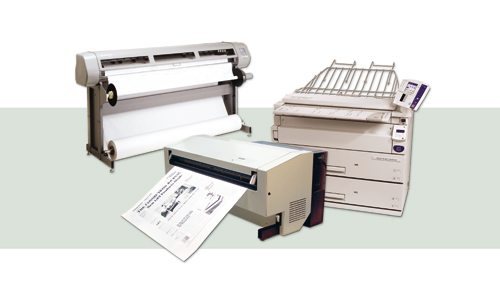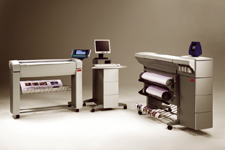Wider Gets Better
The latest large-format printers produce better quality at faster speeds than ever before.
August 1, 2004
By Alan Joch
Wide-format printers are one of a long list of specialized tools engineers need to do their jobs. Thanks to the latest innovations in both color and monochrome print technology, engineers don’t have to sacrifice quality or speed to get the size they need.
Engineering-appropriate printers typically accommodate output sizes of 24 to 44 inches. While some printers can create 60-inch to almost 100-inch images, they’re primarily designed for sign-age and other graphics use rather than engineering output.
Echoing their plotter roots, large printers of the past chiefly worked to produce black-and-white line drawings of designs at various stages in their evolutionary process. But today, engineers are expanding beyond the monochrome world, and are choosing either inkjet printers that do double duty in color and black-and-white, or they’re selecting two separate models for each type of output, perhaps an inkjet machine complemented by a laser printer.

Above, left: The Ioline FlexJet produces 300 to 600 dpi line quality with print widths of up to 72 inches. Middle: Imaging Systems machines have plotting speeds up to 2 ips and print widths from 24 to 36 inches. Right: The Xerox 6050 prints documents up to 36 inches wide and offers onboard scanning.
Inkjet Innovations
The color push is being advanced by increasingly sophisticated and economical rendering and visualization software applications that let engineers create detailed models and color representations, which take ideas from the original concept and initial design to a 3D color rendering and final schematics. That’s the word from Sandy Gramley, DesignJet product manager for Hewlett-Packard of Palo Alto, California. “Wide-format printers are moving to handle the entire process. Engineers don’t just print line drawings anymore, they also need photo-quality printing,” she says.
Other inkjet printer vendors are seeing similar trends. Neal Baessler, product manager with Western Graphtec Inc. in Irvine, California, says 3D renderings let engineers more easily communicate their ideas with customers.
“3D design software has made huge progress in image quality,” he says, “and large-format printers must be able to reproduce all the subtle gradations in colors. If you’re doing CAD drawings, there is only a certain amount of colors you’ll need, but when you’re producing a 3D rendering, it gets down to how photorealistic can you make this drawing. If you show the customer what the final product will look like, it’s a real selling point.”
Color isn’t the only concern for engineers. Of equal importance is the precision with which shapes are reproduced. To meet these output-quality demands, some wide printers now support resolutions of 600 to 1200 dpi (dots per inch).
Because wide-format printers must meet the demands of deadline-driven engineering departments, speed is a third factor that distinguishes individual devices. Supporting bidirectional printing and cramming print heads with thousands of ink nozzles are two ways printer manufacturers are boosting the speed of inkjet printers. For example, Canon USA now ships one-inch print heads that contain more than 7,500 nozzles. They can produce a large-format image at 600 dpi 3 1200 dpi in about 4.5 minutes, says Amit Bagchi, director of Canon’s Graphic Arts Division. Sharper, 1200 3 1200 dpi prints take about seven minutes, he adds.
View the Desktop Engineering Wide-Format Plotters Chart
Canon, headquartered in Lake Success, New York, is one of a handful of vendors introducing new ink technology to further boost print quality. The company recently introduced inks with a special polymer coating that extends print life, says Bagchi.

Right: The Océ TCS400 is a multifunctional system that comprises a print engine, a scan unit, and an integrated Power Logic controller. It was designed to handle complex jobs fast and gives users the option of copying, scanning, and printing wide-format documents in color or black and white on one system.
Laser Focus
High-quality monochrome printers using laser or (the closely related) LED technology are also revealing important innovations in wide-format models. Dedicated to producing sharply defined drawings and schematics, printers in this class are capable of producing 36-inch widths in resolutions of 400 to 600 dpi.
This past spring, Xerox Corp. of Stamford, Connecticut, introduced two new printers, the 6030 and the 6050, both of which offer 600 dpi 3 1200 dpi output quality. The former can produce six pages (24 in. 3 36 in.) per minute, the latter nine such pages per minute, according to Joe Levy, manager of the company’s monochrome wide-format business.
“Customers who need increased image quality are moving up from 400 dpi to 600 dpi printers,” he says, adding that the wide-format market is following the trend toward decentralized printing that was first seen in the general office market. With this “distribute and print model,” engineering firms no longer rely on one or two high-capacity printers stationed in a central location to produce prints for the entire staff. Instead, companies are publishing important documents on their internal websites, where engineers can download the documents and print them on local, departmental printers. “This model is new to the wide-format business, and the advantage is that people get documents on demand” rather than waiting for someone to distribute them manually, Levy says.
The new printers also offer what he calls “background suppression mode,” the ability to produce clear prints from scans of discolored or sepia-toned originals that might otherwise look dark and difficult to read.
Makers of both inkjet and laser printers report that print and scan bundles are becoming popular among engineers. These twosomes match high-quality printers and scanners together for wide-format input and output. “The devices are two separate entities, but often we sell them together in a package so engineers can easily scan in a drawing and print it out,” says Western Graphtec’s Baessler. Xerox’s new monochrome models are even more tightly tied together: Buyers can choose an optional color or monochrome scanner that’s integrated into the printer to create a wide-format multifunction device for a relatively small footprint in space-starved offices.
How to Choose
Because the choices for wide-format printing are so diverse, engineers looking for the right model must first prioritize their needs. Is fast, monochrome printing of schematics and CAD drawings the greatest need? Then look for a high-speed, high-resolution laser or LED printer. Or if speed takes a back seat to high-quality, full-color prints of photorealistic renderings, then one of the new wide-format inkjet models should be the top choice.
Another consideration is whether the printer will serve a single engineer, a small workgroup, or provide a central resource across a network. For network printers, look for devices with an internal hard drive, a built-in network interface, and large ink and paper capacities.
Poring over the speed and capacity ratings vendors publish will help engineers determine the right class of wide-format printers for their needs, but product specs alone aren’t enough for making the final selection. At some point, buyers must make subjective decisions about print quality. To do this, experts advise engineers to avoid the canned printouts from printer manufacturers in favor of custom tests that run from actual engineering applications. The best test prints evaluate a variety of engineering needs. A section composed of lines and dots will help test the printer’s ability to reproduce sharp edges and shapes. A section of the print should include a wide range of gray scales to test how well the printer can produce smooth tonal shadings. Similarly, color printers must demonstrate their ability to produce even color gradations as well as bold and vibrant primary hues. Finally, include a text sample and look for crisp blacks and well-defined edges that make fonts easy to read.
View the Desktop Engineering Wide-Format Plotters Chart
Future Flexibility
The good news is that no matter how faithfully today’s wide-format printers reproduce the colors, tones, shapes, and text that constitute the range of engineering output today, innovations are coming to make tomorrow’s models even better. Vendors say they’re paying special attention to the controllers that manage the speed and accuracy of their printers.
“Future products will be more flexible,” reports Jacob Berenfeld, application engineer with Western Graphtec. “People will be able to easily choose whether to emphasize color accuracy and trade off speed, or vice versa, for each individual print.”
Alan Joch is a business and technology writer based in New England. You can offer him feedback about this article through Desktop Engineering Feedback.
Companies Mentioned
The Imaging Systems Group Inc.
Subscribe to our FREE magazine, FREE email newsletters or both!
About the Author
DE’s editors contribute news and new product announcements to Digital Engineering.
Press releases may be sent to them via [email protected].






